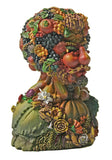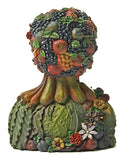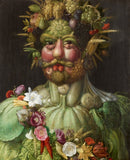Man Portrait Made of Fruits and Vegetables Vertumnus God of Seasons by Arcimboldo 4.5H
PN# AR01This statue adapts a portrait painting of Emperor Rudolph II made out of vegetables and fruits into a desktop collectible figurine. It is filled with discovery as one looks over the complex integration of pears, apples, grapes, flowers, squash, lettuce and others. Surrealist-like, Dali and Magritte were influenced by early artists like Arcimboldo.
Here Emperor Rudolph II is portrayed as Vertumnus, the Roman god of autumn, who's main task it is to guard the orchards and to grant an abundance of fruit. Thus it is a tribute to the wise rulings of the Emperor who enables his subjects to harvest the rich fruit of the fields in peace. Arcimboldo painted this portrait towards the end of his life, in Milan. He had been allowed to return there, but only on the condition that he continued to work for the Emperor.
- Statue figurine is made from resin with hand painted color details.
- Part of the highly collectible Parastone Mouseion 3D Collection of Museum Replicas.
- Measures 4.5 in. x 3.5 in. x 2.5 in. Weighs 1.2 lbs. PN AR01
GIUSEPPE ARCIMBOLDO (CA. 1527-1593): Initially, like his father, the Renaissance painter Arcimboldo worked as a painter on Milan Cathedral. This changed in 1562 when the Emperor of Hapsburg, Ferdinand I, summoned him to the royal court in Prague. Ferdinand's successors, Maximillian II and Rudolph II, were also much taken with Archiboldo's marvelous talents and so, for nearly all of the rest of his life, he remained in the service of this court, not only as a painter, but also as an architect, a designer of bizarre settings and costumes, and an organizer of major festivities. His work was much appreciated both for its sense of craftsmanship as well as its artistic value, and its eccentric, if sometimes comical aspects, may have made a welcome change to the day-to-day harsh political reality. Arcimboldo owes his present-day fame to his artistic discovery of the composite head. He painted his first version of The Four Seasons, portraits composed of flowers, fruit, twigs and leaves, soon after his arrival in Prague.













